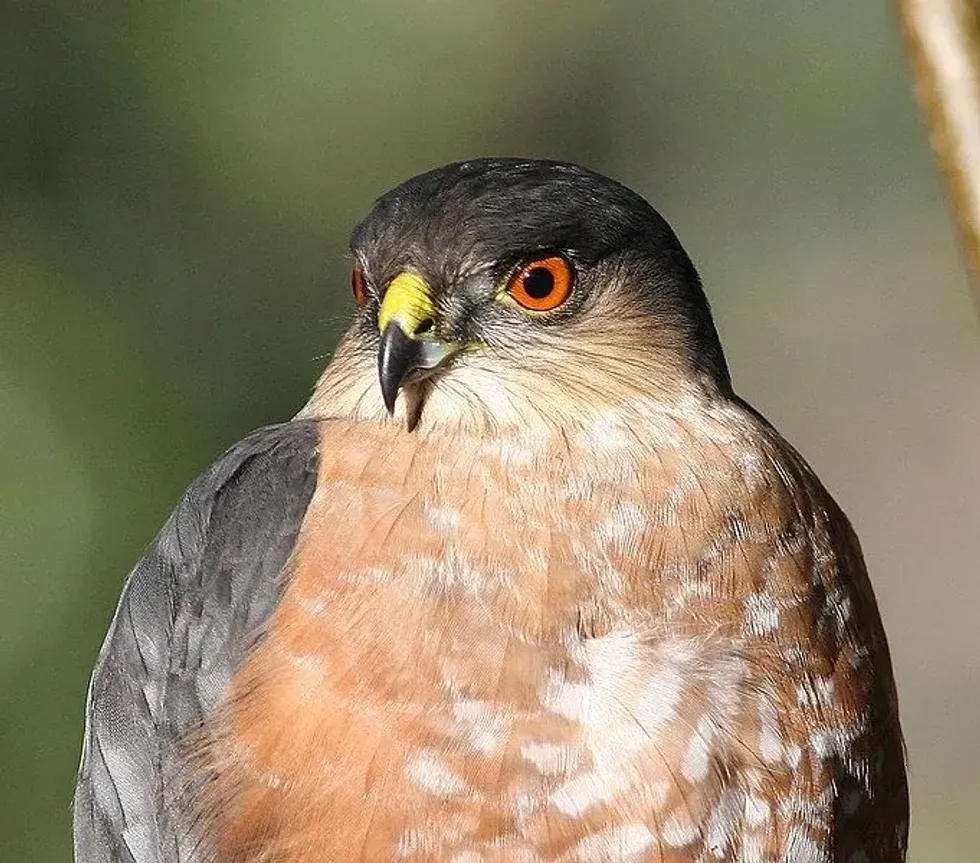The sharp-shinned hawk, Accipiter striatus, is a species of small hawk. They belong to the family Accipitridae and are a member of the genus Accipiter.
The appearance of a sharp, flattened keel on the leading edge of the hawk's long limbs gives it its name. Male hawks of this species are the smallest hawks in Canada and the United States.
Females of this species are bigger than males which causes differences in food preferences. This bird is carnivorous and preys upon smaller species of birds. They are solitary birds who migrate on their own and not in flocks.
This majestic bird has brown plumage overall with orange feathers running down its breast. Immature birds of this species have white feathers with brown streaks running down their breasts.
They are excellent predators who dive through forests and successfully capture their prey. This bird is built to fly rapidly and stealthily through deep woodland as it comes near the potential bird to prey on.
It hunts covertly until it is near enough to capture its prey with a powerful flight. The stealthy features and discreet character allow the bird to startle its prey. They can be seen throughout most of North America, including Mexico.
They can also be seen across Venezuela to northern Argentina. This solitary bird prefers to nest in densely forested areas but it can be spotted in open areas or traveling along mountain ridges during its migration.
Found these facts captivating? We suggest you keep reading and get to know more about this stunning bird! If you like reading about the sharp-shinned hawk, we are sure you will love reading about the harpy eagle and the lark sparrow too.
Sharp-Shinned Hawk Interesting Facts
What type of animal is a sharp-shinned hawk?
Sharp-shinned hawks are birds belonging to the family Accipitridae and are a member of the genus Accipiter. Some of the birds in the northwest are not migratory, but the majority of these hawks are migratory.
Throughout their migration, flocks of these birds may gather at different spots along coasts or mountain ridges. The birds migrate individually, not in flocks. The majority of North American birds of this species spend the winter in the south of the US, while a few travel to places like Mexico and Central America.
What class of animal does a sharp-shinned hawk belong to?
They belong to the class of Aves.
How many sharp-shinned hawks are there in the world?
The exact number of these hawks is unknown. However, declines in their populations have been observed in several locations in recent decades. Environmental toxins, decreasing food availability, and changes in their habitat could all be contributing to these decreases.
Where does a sharp-shinned hawk live?
It can be found in a variety of woodland and forest regions, including both coniferous and broad-leaved trees. The major populations are estimated to be found in forests with mild temperatures.
They often also migrate south to spend the winter in warmer climates. They fly at altitudes of 980-9840 ft (300–3,000 m) but can go as high as 13,000 ft (4,000 m).
What is a sharp-shinned hawk's habitat?
Sharp-shinned hawks prefer to nest in densely forested areas. These birds of prey can be spotted in open areas or traveling along mountain ridges during their migration. Throughout most of North America, including Mexico, these birds can be observed.
They can be seen across South America from Venezuela to northern Argentina. They hunt mammals as well as small birds from backyard bird feeders or along forest borders. These small birds make screeching alarm calls when the predator is near them.
Who do sharp-shinned hawks live with?
These birds are not at all gregarious and all similar species of hawks are not social at all. These birds prefer to live solitarily. They are quiet and focused in nature. Males care for their female mate during the breeding season and live with them then as well.
How long does a sharp-shinned hawk live?
Sharp-shinned hawks have been known to live up to 13 years. The majority, however, do not survive more than three years. Predation, hunting, and accidents with buildings and cars are all risk factors.
How do they reproduce?
The male and the female fly in circles above the forest while making calls during the breeding season. As part of their courtship displays, they spread out their fluffy white under-tail feathers to the side.
Males fly to a high altitude and then drop vertically into the forest. They build their nest over a crow or squirrel's old nest sometimes.
The nest is constructed by both males and females, females majorly, and is lined with bark, grass, and twigs. Their nest is safely hidden in a thick conifer inside the forest at an altitude of 20-60 in (50-152 cm) above ground.
They lay between three and eight eggs that are blue-white and have blotches of brown on them.
These eggs are carefully incubated by the female hawk for 30-35 days. The female is provided with food by the male and the male hawk incubates the eggs while the female hawk eats.
After the eggs hatch, the females stay near them and feed them for one to two weeks. After three to four weeks, the hatchlings can go to branches and even start flying after five or six weeks.
What is their conservation status?
The IUCN status of sharp-shinned hawks is currently Least Concern as they are abundant in their range. However, back in the '60s and '70s, in North America, they faced a decline in their population. These North American birds were significantly facing the side effects of pesticides and DDT at this time.
Sharp-Shinned Hawk Fun Facts
What do sharp-shinned hawks look like?
They are small hawks that have short rounded wings that are quite short. Adult sharp-shinned hawks have thin, orange stripes running down from the front of the neck down toward the legs.
They have slaty blue-gray upper parts with gray caps on their heads, hooked dark-colored beaks, yellow feet, and squared long tails. Immature birds of this species are predominantly brown, with white underparts along with heavy vertical brown streaks.
Both adults and young birds possess thick dark-colored bands running down the length of their elongated tails. They have pale yellow eyes.
How cute are they?
These hawks often look majestic sitting on a perch as their plumage is utterly magnificent. The young birds especially have heavily streaked breasts which look extremely gorgeous.
How do they communicate?
Sharp-shinned hawks are typically relatively quiet birds. During the breeding season, they start making calls, contrary to their quiet nature.
'Kek-kek-kek', as well as 'kik-kik-kik', are their alarming calls. The male sharp-shinned hawk call sounds like 'kip-kip' or 'kew-kew-kew' when it visits the nest, to which the female sharp-shinned hawk responds with a 'keeeep'. 'Eee' cries are also made by the female and the nestlings.
How big is a sharp-shinned hawk?
Female hawks of this species are larger than males. This bird is the smallest when compared to the three North American birds, its relatives, the Accipiters. Their size ranges between that of a crow and a robin. Their range of length is 9.4-13.4 in (24-34 cm) with a wingspan range of 16.9-22.1 in (43-56 cm).
How fast can sharp-shinned hawks move?
They have faster, snappier wingbeats than Cooper's hawks. They have a characteristic flap-and-glide flight technique for flying through wide spaces. Sharp-shinned hawks can fly very quickly and easily, darting through deep forest habitats to catch their prey off-guard. They don't dive to catch it from a great height, but instead, they attack from a low perch or branch.
How much does a sharp-shinned hawk weigh?
Sharp-shinned hawks weigh anywhere in the range of 3.1-7.7 oz (87-218 g). Their average weight is 6.9 oz (195 g).
What are the male and female names of the species?
They don't have distinct names based on their gender.
What would you call a baby sharp-shinned hawk?
A baby sharp-shinned hawk is referred to as a chick, juvenile, young, or hatchling.
What do they eat?
The sharp-shinned hawk (Accipiter striatus) preys upon tiny birds, particularly songbirds namely finches, nuthatches, icterids, tits, thrushes, and wood-warblers as well as sparrows. They rarely consume bats, frogs, lizards, snakes, rodents, and large insects.
Male sharp-shinned hawks hunt smaller birds like wood warblers or sparrows as compared to female hawks, who prey upon larger birds like flickers or American robins. This difference in the type of prey prevents competition and conflict between male and female birds of this species.
These birds of prey use backyard bird feeders often to find flocks of prey. They surprise their prey by capturing them in flight as these hawks can skillfully fly through dense vegetation.
The feathers of their prey are pulled out by this bird. Sharp-shinned hawks also get dragonflies stuck on their feathers during migration, which they ultimately end up consuming.
These hawks have their own set of predators who prey upon them during migration, namely northern goshawks (Accipiter gentiles), bald eagles (Haliacetus leucocephalus), and peregrine falcons (Falco peregrinus). They camouflage themselves in their nest to avoid being seen.
Are they poisonous?
No, these birds are not poisonous but they have excellent predatory skills.
Would they make a good pet?
No, these are wild predatory birds that can not be kept as pets as per federal law. They can neither be tamed nor are they friendly. You can go to hawk watches if you want to observe these solitary birds!
Did you know...
A female is approximately three times the size and weight of a male!
Egg collectors cherish the eggs of these birds as they are richly imprinted with a remarkable variety of colors and marks!
How do you tell the difference between Cooper's hawk and a sharp-shinned hawk?
When it comes to Cooper's hawk vs sharp-shinned hawk differences, sharp-shinned hawks resemble Cooper's hawks in appearance (notably in plumage) but they are smaller than them in overall appearance. They have smaller heads and a more squared tail.
The wings of these birds are also further towards their breast than compared to those of Cooper's hawk. Their gray caps are likewise less noticeable than the Cooper's and their heads are smaller.
The Cooper's hawk's white tail tip is comparatively larger than the sharp-shinned Hawk's, specifically in the autumn season. As the differences are subtle it is tough to differentiate female sharp-shinned hawks from male Cooper's hawks, but it is possible.
Do sharp-shinned hawks eat other birds?
Yes, these birds are clever predators that eat other smaller birds. They prey upon tiny birds, particularly songbirds such as finches, nuthatches, icterids, tits, thrushes, wood-warblers, sparrows, flickers, and American robins.
Here at Kidadl, we have carefully created lots of interesting family-friendly animal facts for everyone to discover! Learn more about some other birds from our keel-billed toucan facts and kea parrot facts pages.
You can even occupy yourself at home by coloring in one of our free printable Sharp-shinned hawk coloring pages.









